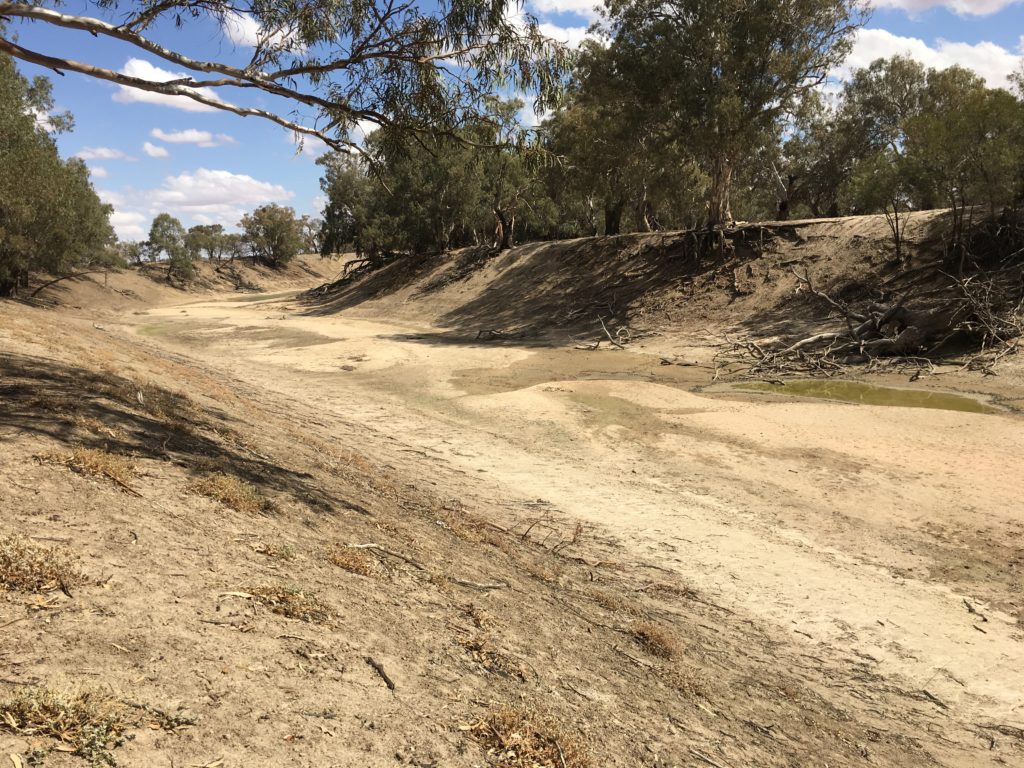By Dr Emma Carmody, EDO Special Counsel and water law expert
It’s 2018 and I’m standing in the far west of NSW on the banks of the Darling River, or Barka, as it is known to its Traditional Custodians, the Barkindji people. I’m listening to Barkindji elder Uncle Badger Bates explain what he means by ‘shut up water’.
‘This little bit of water here’ he says, pointing to the dismal stream beneath us, ‘that’s the water the government releases from the big dams to shut us up.’
The water is an otherworldly green – the gift of a toxic algal bloom – and so low that we could, in theory, shimmy down the banks and walk across to the other side without getting our calves wet.
A few hundred metres upstream, it’s completely dry. This pattern – a bit of ‘shut up water’ interspersed with dusty, dry bed – continues up and down the length of the river.
‘The Barka’, Uncle Badger says with conviction, ‘is a sick patient. It needs to be nursed back to health, and we need our cultural flows to survive.’
Two years later and despite recent rains, the Darling/Barka remains a river in mortal danger. But there is an opportunity for healing.
Legal instruments known as water resource plans have been submitted by the NSW Government to the Murray-Darling Basin Authority for review and, ultimately, final sign off by the Commonwealth Minister for Resources and Water.
These will lock in how water is shared in each catchment in the Murray-Darling Basin (MDB) for the next 10 years. We must get these right if this river system is to recover.
However, as they stand, some of the draft plans for catchments in the NSW MDB arguably do not meet all necessary legal obligations, which could in turn result in legal challenges if they are not amended.
The shut-up water tour, as I affectionately call it, took place six years after the signing of the Murray-Darling Basin Plan and about 15 months before the ecological catastrophe that was the mass fish kills in the Menindee Lakes and Lower Darling River.
In the aftermath of that tragic event, a scientific report confirmed what the Barkindji people already knew – that the fish kills were in part attributable to the long-term over-extraction of water from our northern rivers and floodplains.
It also became painfully clear that the Basin Plan could fail to meet its objectives – in particular the objective to achieve ‘healthy and resilient ecosystems with rivers and creeks regularly connected to their floodplains and, ultimately, the ocean’ – if we didn’t start taking the rule of law seriously. That means returning more water to the environment and protecting that water from extraction.
The report also confirmed that the catastrophe had its roots in another regulatory failure: a failure to prevent the extraction of both water purchased by government for the environment, and ecologically critical ‘low flows’.
This is not just an environmental catastrophe. The human cost for those living in the downstream reaches of the Darling/Barka River and beyond is also immense.

Photo: Ruby Davies
Floodplain graziers living on large properties around Tilpa and Louth have had to endure increasingly long periods without water – or with water that is so putrid as to render it unfit for human or animal consumption.
I’ve had women – third generation farmers and who are as resilient as they are economical with their emotions – break down in tears as they describe having to bathe their young children in fetid, brown water.
I’ve walked along the banks of the Darling/Barka with Uncle Badger and one of his nephews and listened to them explain the links between river health and the health of their people. About how hospital admissions in Wilcannia, a riparian town with a predominantly Aboriginal population, increase when the river is dry or contaminated with algae.
The Barkindji people have had little choice but to endure a legal system that has granted them native title over the river with one hand, then taken away their ability to exercise their customary water rights with the other.
For no one – not even the most determined elder – can teach their grandchildren and great grandchildren how to fish and hunt in a river bed devoid of water and life. Or pay for water entitlements with money that they do not have.
Which brings us back to the water resource plans mentioned above. In many instances, the law – correctly interpreted – requires these plans to include rules to protect environmental water, low flows and the first, crucial flows after a prolonged period of drought.
While these rules are insufficient to meet all of the objectives of Traditional Owners, they would help improve the health of the Barka and other rivers, which is a start.
Unfortunately, in many instances, the draft plans contain no such rules, or they contain rules that are unlikely to meet the needs of the environment and downstream water users.
To be clear – discretionary provisions in these plans that the Minister may ignore are not legally or environmentally fit-for-purpose. Rather, we need binding provisions that provide certainty for everyone – including the river.
Introducing these changes is not a complete panacea. We still need to return more water to the environment if our rivers, aquifers and floodplains are to be resilient and capable of sustaining a variety of consumptive uses in a changing climate.
We still need to change the law so that it advances the rights and values of First Nations Peoples, including through cultural flows, and empowers them to participate in the water market as equals.
However, right now, there is an opportunity to ensure that the water resource plans under review uphold the rule of law and in so doing, avoid the possibility of lengthy legal challenges, which nobody wants.





